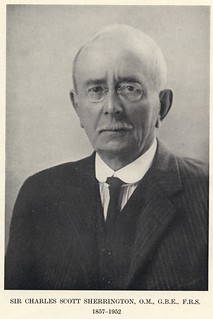- External URL
- Correspondence Details
-
Sent From (Definite): Sir Charles Scott SherringtonSent To (Definite): Karl PearsonDate: 6 Dec 1903
- Current Holder(s)
-
Holder (Definite): University College London
- No links match your filters. Clear Filters
-
Sent from
 Sir Charles Scott Sherrington
Sir Charles Scott Sherrington
6 Dec 1903
Description:
‘Dear Professor Pearson,
Let me first acknowledge your letter in reply to mine about Biology at the Roy. Soc. & thank you for considering the matter & writing so fully as you did.
It was remarkable that our letters crossed.
As to the blood-corpuscles, as different classes that can be distinguished in the tadpole are not markedly otherwise than in the frog. A difficulty in numeridcal estimation of them rises from a typical membership of each class resembling, more or less, members of other classes. These ‘uebergangs formen’ lead to the supposition, neither proven or unproven , that the various forms are phases in the life history of one (or two) Grundformen.
Numerical estimates of the different classes, given by various observers working at one & the same specimen, differ a good deal from observer to observer.
I mention these points without fully knowing your aim, & desiderata in regard to material for observation; but if groups consisting of members easily & precisely deifferentiated from members of other groups be desired for your researches I fear the blood corpuscle would probably not offer a particularly favourable field – although in some respects their diverse activities are remarkable and fascinating to follow.
With kind regards, & feeling it a privilege if I can be of any use to your distinguished labours,
believe me very truly yours,
C.S. Sherrington.’
-
Sent to
 Karl Pearson
Karl Pearson
6 Dec 1903
Description:
‘Dear Professor Pearson,
Let me first acknowledge your letter in reply to mine about Biology at the Roy. Soc. & thank you for considering the matter & writing so fully as you did.
It was remarkable that our letters crossed.
As to the blood-corpuscles, as different classes that can be distinguished in the tadpole are not markedly otherwise than in the frog. A difficulty in numeridcal estimation of them rises from a typical membership of each class resembling, more or less, members of other classes. These ‘uebergangs formen’ lead to the supposition, neither proven or unproven , that the various forms are phases in the life history of one (or two) Grundformen.
Numerical estimates of the different classes, given by various observers working at one & the same specimen, differ a good deal from observer to observer.
I mention these points without fully knowing your aim, & desiderata in regard to material for observation; but if groups consisting of members easily & precisely deifferentiated from members of other groups be desired for your researches I fear the blood corpuscle would probably not offer a particularly favourable field – although in some respects their diverse activities are remarkable and fascinating to follow.
With kind regards, & feeling it a privilege if I can be of any use to your distinguished labours,
believe me very truly yours,
C.S. Sherrington.’
-
Currently held by
 University College London
University College London
Description:Special Collections. Ref. No. PEARSON/11/1/18/78










